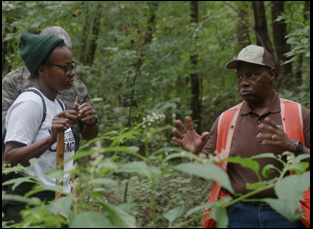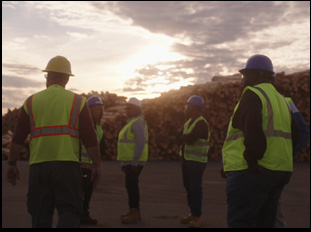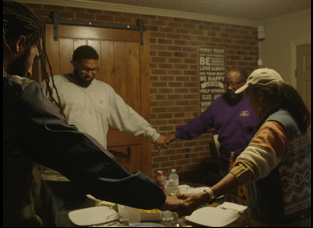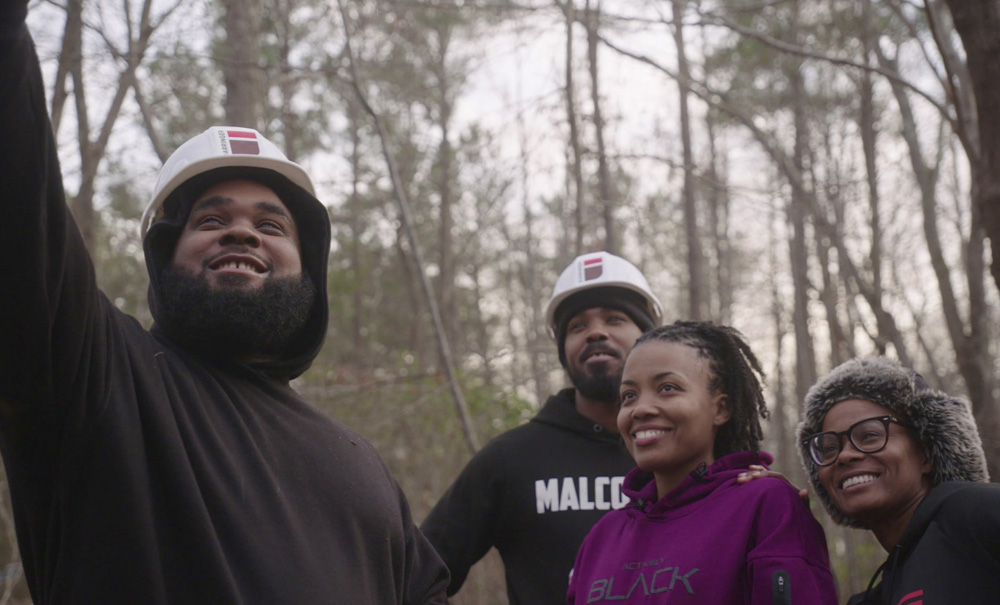Jennifer MacArthur knew her family had some land in Virginia, but it wasn’t until she was in the midst of making “Family Tree” that she thought to ask about its roots as an heirs property, acreage that many Black families in particular held that had been passed on from generation to generation without being documented in a will.
“One day I called up my sister and I was like, “Vicky, is this us?” MacArthur said as she started looking into the families who would be the subjects of her first feature, each cultivating their property in North Carolina to create a sustainable future for themselves and the environment. “I would talk it through and it was this really interesting moment of self-awareness, working with these families and realizing our connection and that so many other Black families probably also have the same thing going on, but don’t have the language and don’t know how to describe the situation with their land.”
MacArthur ends up articulating it beautifully in “Family Tree,” settling in with two families connected by not only a highway in the Tar Heel State, but the services of the Sustainable Forestry and African-American Land Retention Project, which has helped families with land connected to forests and farms make the best use of their soil. While the Williams family are experts at this point, putting the last 30 years into running Fortee Acres, which as patriarch Tyrone says is not only a nod to the promise made to former slaves coming out of the Civil War, but to the four children whose names start with T that he hopes one day will take over for him, the Jeffries family are only starting to make use of their land, learning that some of their trees are particularly coveted for use as barrels for bourbon.
“Family Tree” observes the physical work that goes into conservation that will keep up property values as well as clean air, but MacArthur shows the equal care that goes into building stronger relationships amongst the families as they do this work together, having a common goal to bring them closer and considering the idea of generational wealth, which has been particularly elusive for Black families, beyond what can be measured in a bank account. Some conversations aren’t easy, but MacArthur eases audiences into a complex subject with an unusually sunny disposition towards the material as the families move through trial and error with their agricultural pursuits and their internal dynamics to see what makes sense moving forward. The film itself has been unstoppable since its premiere at Full Frame earlier this month and made its international debut at Hot Docs this weekend before heading to Atlanta and MacArthur graciously took the time to talk about how setting up “Family Tree” to tell a different kind of story than ones you might be used to seeing regarding its subject matter, honoring the trust her subjects placed in her and the film’s visual influences.

I grew up in ex-urban and semi-rural environments and when I was 23 years old, I moved to New York City to make it big. After 20 years, I got this sense of wanting to reconnect and tell stories about nature and our deep connection to it and how it sustains us. North Carolina ended up being the place where we found we could explore those kinds of themes and connections that I was interested in. I worked with a great researcher, Nadine Natour, who was looking for a way into how do we do this intersection between African-American life and environmentalism [which] isn’t about environmental justice, where [it’s] fighting against that chemical company or the stories that we already associate with Black people. She found the Sustainable Forestry and African-American Land Retention Project and learned about the work that they do with Black families to help them keep their land through sustainable forestry. They helped us find different families that might be interested in being on camera.
We wanted to look at different aspects of sustainable forestry and some of the challenges that African-American families specifically face, so the Williams family really represents the continuation of a legacy, and how do you pass things down and what are the legal things that you need to do, and then [with] the Jeffries family, we were looking to tell a story about families that needed access to resources and were new to this whole thing and trying to figure out how do we make sense of this. Because of those two basic things, we were going to find a family that was newer to it and then one that was more further along in their journey.
You set such a wonderful tone with the introductory credits, which is so bright and cheerful and looks more like the start of a sitcom than a doc. Was that tone in mind from the start of actually making this?
Yes. I really wanted to tell a story about Black life that was not as I call it racism or trauma porn. There’s a lot of that, and I understand people want to fix the things that are bad, but storytelling allows you to open up a different window into people and how they feel about something. So I wanted to give people a sense of African-Americans with agency and who were joyful and even if there were challenges, these families were still intact. I also really wanted to play with the ‘70s or ‘80s nostalgia of channeling the aesthetics of the opening of “Dallas” or “Dynasty.” That would help people understand the genre of film I was trying to make, so I always had those ideas in mind and as we got closer to post-finishing, I decided I wanted to do this.

First of all, Rafael Roy, my DP, is just a genius, and we’ve worked together for many years now on a number of other projects. He has such a gentle style and he’s unobtrusive. People just don’t even know he’s in the room, so that’s partly why we were able to get these very intimate moments. I told him from the beginning that I really wanted it to look like “A River Runs Through It” — that’s a really big influence for this film, as well as “Killer of Sheep,” and just the children running around and that dynamic of the family sitting around the dinner table.
I also wanted to make something that feels like a big Hollywood blockbuster in a way, a family dramedy, so when we got down on the ground, we really started to work with the camera and the last piece was really bringing in the natural environment to make it a character in the film. That we came to while we were shooting and there were a few things that would happen to be like, “From here, let’s look at this. Let’s look at that. From these little mushrooms down here, let’s shoot from their angle,” so we wanted to bring in those elements as well.
Was there anything that changed your idea of what this was?
We got deeper into the family stories than I initially anticipated. I wanted to get closer to the families, but getting to the point where we were able to go to a therapy session with the Jeffries was huge. It was not something that I even asked for. It was actually driven by them. They wanted to invite us into that process, and I initially really resisted it because I was afraid of getting the camera in the space that’s so vulnerable. But they [said], “We trust you. We want you here. We want to show other families what this process of healing looks like, and it really makes the emotional arc of the story and Sidney’s [role in it] shift.
And this film is really about fatherhood and black men and black masculinity and what that means and what that looks like. My father’s been gone for over a decade, but for me, Sidney and Tyrone really represent my father in a lot of ways at different stages of his life, so I feel very close to both of them and wanted to explore these different aspects of my father’s character and personality through these men.

It blew my mind. The extended families [of our subjects] came out, and I’ve been working with the North Carolina branch of the Sustainable Forestry and African-American Land Retention Project really closely for two years now and they worked with me to get the word out. They purchased 50 tickets and just got families from all over North Carolina to the screening and Full Frame [itself] was wonderful. They programmed us in the Carolina Theater in Fletcher Hall, which is their 1000-seat theater and we packed it. I wanted the film to be funny and I thought it was, but you never really know until you’re in a room with people watching it. People just started laughing from the beginning and found the joy and the humor in it, and I cried, to be honest. I felt people really understand the story that I was trying to tell, so that was really exciting.
You have a secret weapon in Avery, the youngest member of the Jeffries’ family.
Avery steals the show. She is so cute and now three times as big. Kids grow so fast, and she was at the screening and it was really exciting for her to see herself on camera.
It’s also your first feature. Was the experience of it what you thought it would be?
It was more than I thought it would be. It was such a revelation in terms what you understand your responsibilities to the people that you film and getting their characterization right. You know them and the people in their community know them, but you’re about to introduce them to the world extensively and you’ve got to get that right. I still feel that responsibility. I’m excited to be here at Hot Docs because this is a different kind of audience from the one in North Carolina that was really a hometown premiere, so I’m hoping the industry and then the local community in Toronto will connect with the story and the families in the same way.
“Family Tree” will screen again at Hot Docs on April 29th at 1:30 pm at the TIFF Lightbox 2. It will next screen at the Atlanta Film Festival on May 5th at 4 pm at the Plaza Theatre and available to stream online through the festival’s platform from May 6th through May 12th.




